 As the grand finale of our year-long journey, we could hardly have done better than a visit to Machu Picchu. What can I possibly say about this spectacular place without repeating what thousands of other visitors have already said? Beautiful, fascinating, an architectural wonder, blah, blah, blah. I’m not irreverant, but I can’t offer anything original.
As the grand finale of our year-long journey, we could hardly have done better than a visit to Machu Picchu. What can I possibly say about this spectacular place without repeating what thousands of other visitors have already said? Beautiful, fascinating, an architectural wonder, blah, blah, blah. I’m not irreverant, but I can’t offer anything original.
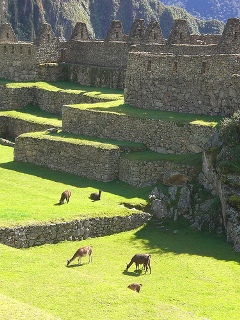 However, I thought the resident llamas were a nice touch. Apparently, they were brought to site years ago by a production company that was filming an historical documentary and, when filming was over, they just left them there. They’ve been hanging around mowing the lawns ever since. Just in case one tires of photographically documenting every carved stone in the city, one can focus on these living local icons.
However, I thought the resident llamas were a nice touch. Apparently, they were brought to site years ago by a production company that was filming an historical documentary and, when filming was over, they just left them there. They’ve been hanging around mowing the lawns ever since. Just in case one tires of photographically documenting every carved stone in the city, one can focus on these living local icons.
When we started this trip, we thought it would be interesting to have a theme. One of the suggestions was to make it a tour of UNESCO World Heritage Sites. How clever and cultured we would be! However, these are way more numerous than I thought (830 properties) and we seemed to follow that theme without even trying. Towards the end, it was like, “What, this is another World Heritage Site?” I don’t know what the criteria are for earning this designation but its seems that all you have to be is, a) older than 100 years and, b) on a tourist trail.
It turns out that it would’ve been more interesting to have adopted the theme of Seven Wonders, Old and New. Of course, we’d only have been able to visit the supposed locations of six of the Ancient Seven, but the ones that could be considered new would have been reasonably accessible. Indeed, it seems somewhat poignant that Machu Picchu was our final destination as it is in the running for the new “official” list of the Seven Wonders of the Modern World. Thus, it prompted the question of how many other Wonders have we visited in the past year; of the twenty contenders, we have explored eight: the Colosseum, the Eiffel Tower, the Great Wall of China, Machu Picchu, the Taj Mahal, Angkor Wat, Hagia Sophia, and the Kremlin & St.Basil’s Cathedral. Only twelve more to go! Our path seems determined.
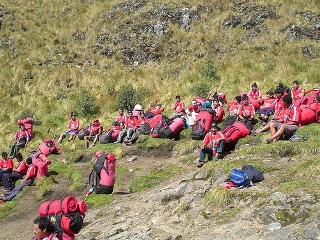 For our group of 11 clients, there were 2 guides, 1 cook and 16 porters. They carried everything we would need for our trip, less the sleeping bag and sleeping mats that we carried ourselves. I was struggling with a little over 7kgs. in my pack so I find it remarkable that the porters carrying the propane tank, or the folding tables, or the cook stove were breezing past me at a steady pace. That work is some Jesus hard. (Marc is hidden somewhere in this picture of our porters in their uniforms during a rarely seen break.)
For our group of 11 clients, there were 2 guides, 1 cook and 16 porters. They carried everything we would need for our trip, less the sleeping bag and sleeping mats that we carried ourselves. I was struggling with a little over 7kgs. in my pack so I find it remarkable that the porters carrying the propane tank, or the folding tables, or the cook stove were breezing past me at a steady pace. That work is some Jesus hard. (Marc is hidden somewhere in this picture of our porters in their uniforms during a rarely seen break.)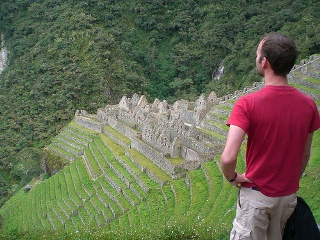 At any rate, we were regularly rewarded during our trek with some excellent opportunities to explore various Inca ruins. I think my favourite is Winay Wayna, a small city perched on the very edge of a mountain-top near Machu Picchu. The theory is that it was used mainly an agricultural establishment which provided much of the food needed at MP. The terraces, the water management system, and the remaining buildings are fantastic feats of architecture- it was just fascinating to me to see how they had built a city and a farm on the side of steep, unforgiving mountain.
At any rate, we were regularly rewarded during our trek with some excellent opportunities to explore various Inca ruins. I think my favourite is Winay Wayna, a small city perched on the very edge of a mountain-top near Machu Picchu. The theory is that it was used mainly an agricultural establishment which provided much of the food needed at MP. The terraces, the water management system, and the remaining buildings are fantastic feats of architecture- it was just fascinating to me to see how they had built a city and a farm on the side of steep, unforgiving mountain.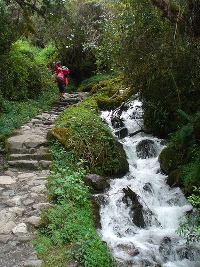 The trail to Machu Picchu was built roughly 500 years ago, before the arrival of the Conquistadores. Our guide told us that the first 2 days of trekking is on trail that is only about 30% original but that on the third and fourth days, the trail is 80-90% original. Considering that the road is paved with stone and snakes through cloud jungle, over extremely high mountain passes, and skirts whole valleys, it is beyond remarkable that it has remained intact, let alone in good enough shape for people to continue to traverse it.
The trail to Machu Picchu was built roughly 500 years ago, before the arrival of the Conquistadores. Our guide told us that the first 2 days of trekking is on trail that is only about 30% original but that on the third and fourth days, the trail is 80-90% original. Considering that the road is paved with stone and snakes through cloud jungle, over extremely high mountain passes, and skirts whole valleys, it is beyond remarkable that it has remained intact, let alone in good enough shape for people to continue to traverse it. The highest point we crossed, Dead Woman’s Pass (doesn’t take much imagination to wonder why it has this name) was 4215m. (13829ft.), not a height that I will take lightly anymore. The altitude took its toll on both of us, sapping our strength and only allowing 20 steps between rest stops. Luckily, we had acclimatized for a couple of weeks before setting off but some of our group had a rough time with altitude sickness, unfortunately. Fortunately, we discovered coca leaves. Yes, they are of the plant of ill repute but I found that tucking a wad in the side of my mouth and chewing on these bitter leaves actually made quite a difference in my performance; I felt less headache-y and a little more energetic. It was much nicer, however, to chew on a coca candy and/or take a little coca mate (tea) and significantly less gross than the wad of leaves.
The highest point we crossed, Dead Woman’s Pass (doesn’t take much imagination to wonder why it has this name) was 4215m. (13829ft.), not a height that I will take lightly anymore. The altitude took its toll on both of us, sapping our strength and only allowing 20 steps between rest stops. Luckily, we had acclimatized for a couple of weeks before setting off but some of our group had a rough time with altitude sickness, unfortunately. Fortunately, we discovered coca leaves. Yes, they are of the plant of ill repute but I found that tucking a wad in the side of my mouth and chewing on these bitter leaves actually made quite a difference in my performance; I felt less headache-y and a little more energetic. It was much nicer, however, to chew on a coca candy and/or take a little coca mate (tea) and significantly less gross than the wad of leaves.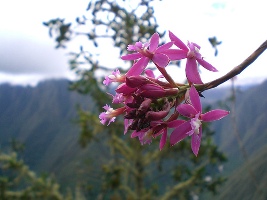

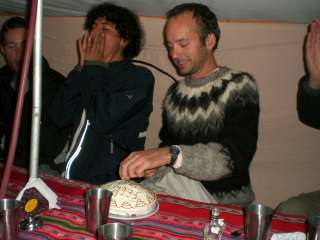 On the second day of our Inca Trek one of our fellow trekkers overheard Janet and I talking about my birthday. He brought it up at lunch and by dinner the tour company had arranged a little celebration.
On the second day of our Inca Trek one of our fellow trekkers overheard Janet and I talking about my birthday. He brought it up at lunch and by dinner the tour company had arranged a little celebration.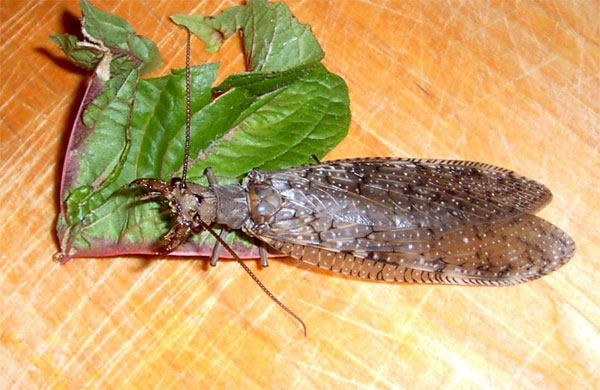 I was just bitten by the biggest insect I have ever seen. I took off my jacket and started walking around when I felt a pinch on my finger. When I looked under my coat I saw a long brown something and dropped the coat. Out crawled a four or five inch long brown insect, which looked up at us gnashing it’s half-inch mandibles and waving it’s antennae for a few seconds. Then it spread its wings and flew towards us before veering off to land in a tree. I haven’t been able to find out what it was.
I was just bitten by the biggest insect I have ever seen. I took off my jacket and started walking around when I felt a pinch on my finger. When I looked under my coat I saw a long brown something and dropped the coat. Out crawled a four or five inch long brown insect, which looked up at us gnashing it’s half-inch mandibles and waving it’s antennae for a few seconds. Then it spread its wings and flew towards us before veering off to land in a tree. I haven’t been able to find out what it was. In the mess tent, with real tables and chairs, we were presented with a first course of delicious chili-vegetable soup followed by a main course of stuffed chicken in cream sauce, tender beef in gravy, fresh beet and apple salad, garlic bread, fluffy rice, and delicate toasts with mandarin-raisin salad. I was agog. How he could´ve conceived such an elaborate meal -nay, feast! – in such an environment is amazing. And to this meal was added the vino. Maybe it was the altitude, or the aching muscles or the good company, but that wine was a lovely slice of luxury next to that dinner.
In the mess tent, with real tables and chairs, we were presented with a first course of delicious chili-vegetable soup followed by a main course of stuffed chicken in cream sauce, tender beef in gravy, fresh beet and apple salad, garlic bread, fluffy rice, and delicate toasts with mandarin-raisin salad. I was agog. How he could´ve conceived such an elaborate meal -nay, feast! – in such an environment is amazing. And to this meal was added the vino. Maybe it was the altitude, or the aching muscles or the good company, but that wine was a lovely slice of luxury next to that dinner.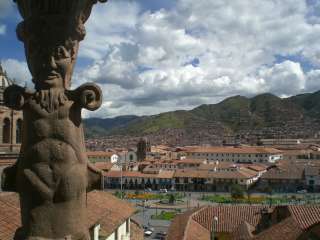 If I were forced to describe Cusco in terms of what other city in the world it most closely resembles, I think I would say “Florence, Italy.” This picture especially illustrates my point with its red-tile roofs and late 16th century architecture. Plus, with all the plazas and an abundance of churches, it really does seem to have a lot in common with it’s Italian cousin. Of course, having never been to Spain myself, it may be that Cusco closely resembles a city or two there, given that it was conquered by the Spanish…
If I were forced to describe Cusco in terms of what other city in the world it most closely resembles, I think I would say “Florence, Italy.” This picture especially illustrates my point with its red-tile roofs and late 16th century architecture. Plus, with all the plazas and an abundance of churches, it really does seem to have a lot in common with it’s Italian cousin. Of course, having never been to Spain myself, it may be that Cusco closely resembles a city or two there, given that it was conquered by the Spanish…

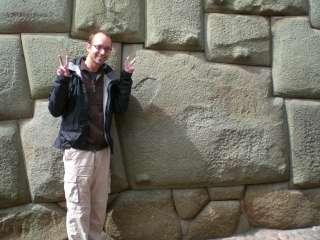 In this pic, Marc is posing beside the famous “Stone of 12 Angles”, which was not only in the wall past which we walked several times, it was nearly constantly the focus of a tour group. Sometimes we can be so unobservant.
In this pic, Marc is posing beside the famous “Stone of 12 Angles”, which was not only in the wall past which we walked several times, it was nearly constantly the focus of a tour group. Sometimes we can be so unobservant.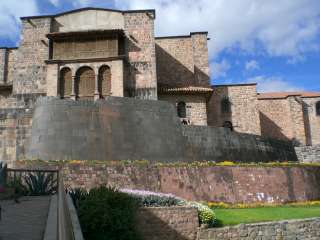
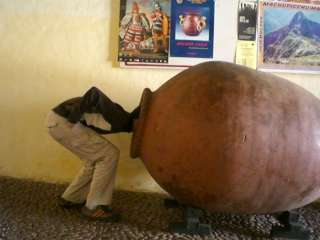
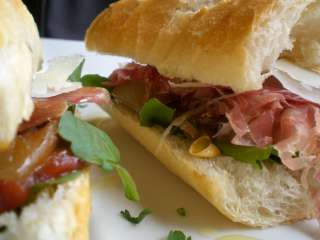

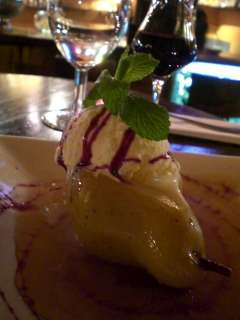 The alpaca was much like a beef steak, but a little tougher and stringier, although not unpleasant or strongly flavored. I played it safe with lamb. The surprise turned out to be the mashed starch, which tasted like liver had been added. On it’s own it wasn’t particularly pleasant, but when tasted with the lamb it became a rich earthy flavor that wasn’t overpowering. For dessert we tried the pear poached with lemongrass and coriander.
The alpaca was much like a beef steak, but a little tougher and stringier, although not unpleasant or strongly flavored. I played it safe with lamb. The surprise turned out to be the mashed starch, which tasted like liver had been added. On it’s own it wasn’t particularly pleasant, but when tasted with the lamb it became a rich earthy flavor that wasn’t overpowering. For dessert we tried the pear poached with lemongrass and coriander.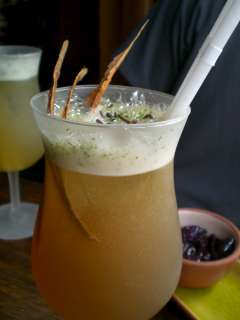 Everything was so good we stopped in for lunch this afternoon and our sandwiches did not disappointed. I ordered the serrano ham with machengo cheese, roasted red peppers, carmelized onions and organic arugula grown in the nearby Sacred Valley. Mmmm, sacred lettuce. Although none of those ingredients are particularly unusual, they were all very high quality and complimented each other extremely well. It’s hard to go wrong with carmelized onions and arugula. Janet ordered a tasty teriyaki chicken sandwich with avacado, toasted seasame seeds and organic greens. Our drinks were equally special—lemonade with mint and ice tea with mint, cinnamon sticks, and whole cloves.
Everything was so good we stopped in for lunch this afternoon and our sandwiches did not disappointed. I ordered the serrano ham with machengo cheese, roasted red peppers, carmelized onions and organic arugula grown in the nearby Sacred Valley. Mmmm, sacred lettuce. Although none of those ingredients are particularly unusual, they were all very high quality and complimented each other extremely well. It’s hard to go wrong with carmelized onions and arugula. Janet ordered a tasty teriyaki chicken sandwich with avacado, toasted seasame seeds and organic greens. Our drinks were equally special—lemonade with mint and ice tea with mint, cinnamon sticks, and whole cloves.